THE SOUTHWELL EXCURSION.
The second excursion for the year 1898 was made on the 20th July. The party started from King Street, Nottingham, just before half-past nine. Among those present were Rev. T. W. Swann, Mr. James Ward, Mr. F. W. Neale, Mr. & Mrs. Geo. Harrison, Mr. J. Potter Briscoe, Mr. W. Bradshaw, Miss E. A. Gleave, Miss Guilford, Professor Granger, Mr. J. T. Radford, Mr. W. R. Gleave, Mr. Henry Gee, Mr. R. Whitbread, Mr. Chas. Gerring, Mr. Edward Renard, Mr. P. J. Cropper, Mr. Henry Ashwell, the Rev. R. J. Burton, Mr. W. Wells, Mr. R. H. Whitworth, the Rev. A. M. Y. Baylay, the Rev. J. Standish and Mr. W. P. W. Phillimore (hon. secs.), and others.
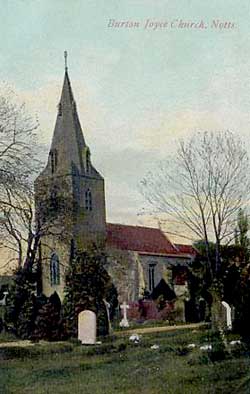 Burton Joyce church, c.1905.
Burton Joyce church, c.1905.Arrived at Burton Joyce Church the Rev. A. M. Y. Baylay, vicar of Thurgarton, took them over the building. Describing the most ancient existing feature of the church— the east window of the north aisle, he stated it was similar in character to the well-known example at Raunds, Northamptonshire, dating from about 1250. The lowest courses of the north wall, he pointed out, were also very ancient, and said that the late Bishop Trollope considered them to be Saxon, but that it was more probable that they were of the same date as the east window of the aisle. With regard to the tower, spire, the arcades of the nave, and the chancel arch, some people believed they were earlier than the window referred to, but a careful examination of the details led him to conclude that they were later. When that work was carried out it would seem that for some reason or other the axis of the nave was shifted southwards, so as to bring it out of line with that of the chancel. The existing chancel was of late 14th century work, but there was reason for thinking that it stood on the foundation of an earlier chancel. Why was the axis of the nave shifted ? It was not easy to say, but he was inclined to think that the family of de Jorz, then all powerful in the place, demanded a wider space for their family chapel, and obtained it by thus thrusting the nave on one side, at the same time opening out the large squint which now commanded a view of the high altar. At that date they seemed to have rebuilt the north wall, and inserted in it the curious recess with a small window, which still remained. It was, he thought, a reading window, intended for the chaplain of the chapel to sit in and read his office. The monument, supposed to be that of Robert de Jorz, who lived in the time of Edward II., used to be in the north aisle, and in Thoroton’s time was in its proper recumbent position. At a later date it was absurdly stuck upright in the recess of the reading window. The slab of the chapel altar, which now stands against the east wall, proved that the custom of putting relics into the slab was by no means universal in the medieval English Church. Turning to the chancel they found that in 1349 William Zouch, Archbishop of York, having conveyed the tithes of Burton Joyce to the Prior and Canons of Shelford, enjoined them to rebuild the chancel, which seemed to have been out of repair. They probably rebuilt it on the old foundations, and they appear to have retained the piscina of the earlier church. Mr. Baylay had been unable to find any traces of a rood loft. The tombs of the Stapletons, now in the south aisle, were originally in the chancel. Perhaps that family obtained the great tithes of Burton Joyce at the dissolution of Shelford Priory before they passed to the Stanhopes. At all events, they became very powerful in the parish, and aggressed their neighbours. The south aisle was rebuilt in the 18th century in a hideous style, but with excellent masonry, some of which might be seen on the outside. It was rebuilt in 1878. Lastly, the tower and spire deserved notice, first because broach spires were rare in the district, nearly all our spires springing within a parapet, and secondly because the type of broach spire seen here was a peculiar and very picturesque one, most of the other examples of which were to be found somewhat south of this, towards the borders of Leicestershire. The top was rebuilt a few years ago. On the north of the tower there was formerly a schoolroom. He had a suspicion that before it was a schoolroom it might have been the brewhouse for the church ale—which not infrequently was placed in such a position.
The following rough notes of a visit to Burton Joyce in September, 1870, made by Mr. Phillimore, Hon. Secretary of the Society, may be preserved here as describing the church prior to its restoration :—
There are three entrances to the church, one in the tower, but not now used, a plain, modern, square-headed one in the west side, one on the south side by the porch before-mentioned, and a third on the north side. The south aisle is in the palladian style, and being in the same style as Colwick tower and chancel, is probably about the same date, viz., 1684, and is remarkable for having no east window. There is but one monument in this aisle, a modern one, to the late Robert Padley, Esq. The nave is divided from each aisle by four round arches, springing from well-carved capitals. There is a font at the south side of the tower arch, and now unused except as a receptacle for old candles, brushes, etc. It is supported by pillars and has a finely quatre-foiled bowl, and has formerly been a very fine one in the early English style. One or more of the pillars are now wanting. The children at present are baptised in a bowl. The pulpit and reading-desk are situated at the south-east angle of the nave. There is an old Bible, title-page gone, in black letter with scriptural pedigrees; it is incomplete in other respects. There is a similar one at Beeston. The date is about 1640. The parish clerk told me that formerly there was another much older with large clasps, but now lost. There is also a Book of Homilies, bought, as appears inside the book, by the order of the Archdeacon, for the use of the inhabitants of Burton Joyce, about 150 years ago.
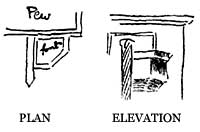
On the other side of the nave, opposite to the reading-pew, is a tin ledge, capable of holding a small basin. Into this basin the vicar in the reading-pew used to stretch his hand across, so that he could baptise the children without stirring out of his pew. The north aisle is by far the most interesting portion of the church. It has a door and three windows. The more easterly of the two north windows has been originally a very fine one, but now the mullion has disappeared. The east window is a fine one, but the quatre-foils have been changed into circles.* This aisle has doubtless had a chapel partitioned off at the east end, for the space between the most easterly pillar and the chancel is walled up, and a south piscina inserted. Close to it is a small brass. In a niche in the north wall of this aisle is the effigy (standing upright) of an armed knight, habited in a coat of chain-mail. Over this he wears a surcoat, the bottom of which is cut into lappets. His head is encased in a conical bassinet, and rests on a square pillow placed diagonally on another long one. He wears large gauntlets. The legs are covered with plate armour; a spur remains on the left heel, and both feet rest on a couchant lion. Suspended from a belt decorated with roses is a small dagger, but there is no sword. On his left arm he bears a shield cut in half longitudinally, and on it a bend charged with three water bougets. Close to the floor along the wall are the two sides of the tomb, the ends are gone. Each side has four shields enclosed in as many quatre-foils. Six out of the eight shields are blank. The position formerly occupied by this effigy is now marked by a plain slab, it was removed in order that more pews might be made. Formerly there were no pews opposite where the effigy now is. In this aisle is an ancient carved oak bench of pre-Reformation date. There is no stained glass in this aisle.
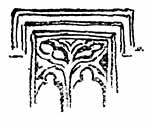
The chancel is also very interesting. The south wall is in a line with the south pillars of the nave; but the north wall extends across part of the breadth of the north aisle, with an arch opening from the chancel into that aisle. The east window is in the perpendicular style, but a very poor specimen. The two windows on the south side are filled with flamboyant** tracery. There are no windows on the north side. The ceiling, which is lower than either the tops of the chancel arch or the top of the east window, shelves to each of these points. There is no piscina or sedilia visible. On each side of the chancel are two large plain tombs covered with marble slabs incised with figures and inscriptions. The north one has the incised figure of Sir Brian Stapleton.
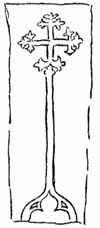
SEPULCHRAL CROSS AT
BURTON JOYCE.
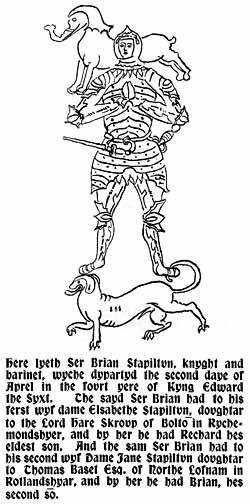
The inscription is very perfect, and the knight is represented in full armour, his feet resting on a talbot and his head on an elephant which has hoofs. A great part of the south tomb, which is like the north one, is worn away. On the north wall is a marble tablet with the figure of a woman with a hat on kneeling at a desk. On each side of her are references to Scripture, now illegible. The chancel is partly pewed. There is no screen. There is a very plain wooden Communion table, which is painted oak. There is one floor-stone. The painted glass mentioned by Thoroton has disappeared, except one small fragment in the east window.
The inscription on the companion tomb is as below, but the portion in square brackets is now illegible, and has been supplied from Thoroton.
Here liethe the bodi of Alis Roose, dovghtere of Fravnces [Rous of Laxston in the County of Nottingham Esquier,] first wiffe to Brian Stapiltvn Esq : yovnger sonne of Sir Brian Stapiltvn Knight, after wiffe to Anthonie Stapiltvn of Remson Esquier, lastle wiffe to Thomas Leeke of Hasland in the covntie of Darbie Esqvier The [said Alis was buryed the 5th day of] Janvari in [the year of our Lord mvc. d. ave] (perhaps 1595 is intended).
On tablets at the east end of the South aisle:—
Sacred to the memory of
ROBERT PADLEY
of Burton Joyce in the County of Nottingham Esqre.
who died on the 16th day of June 1833
Aged 78 years.
In the course of a long and useful life he
upon the threatened invasion of his country
by the French
raised and commanded a corps of volunteers
called the Trent Vale Volunteers.
He also filled the office of
Justice of the Peace for the County of
Nottingham.
And of ANN PADLEY his wife
ELDEST DAUGHTER OF THE LATE JOHN NEWTON
of Bulwell Hall in the said County
of Nottingham Esqre.
She died on the 17th day of September 1833,
Aged 74 years
and also of JOHN NEWTON PADLEY second son of
the said Robert And Ann Padley,
He died on the 7th day of December 1834
Aged 48 years.
Their mortal remains are deposited in a vault
on the South West side of the porch of this Church.
“ Blessed are the dead who die in the Lord.”
To The Revered
and Cherished Memory of
WlLLM. JAMSON, who DIED JUNE 3, 1829, AGED 66,
& Ann Maria, his wife died March 11, 1827, aged 53.
This Tablet is here placed
By their Children.
“ Blessed are the dead who die in the Lord."—Rev. xiv., 13.
“ Their children arise up and call them blessed."—Prov. xxxi., 28.
In the same vault lie the bodies of
Ann Frances, their Daughr. who died April 5, 1810 aged 10
and William, their Son who died Decr. 2, 1809
Aged 3 months.
Consecrated
to the precious Memory of SARAH
the beloved Wife of John Jeremiah Bigsby M.D.
& second daughter of Willm. & Ann Maria Jamson
She died Sept. 25, 1835 aged 33 years.
“ Her conversation was in heaven."—Phil. iii.
O ye Villagers ! for whom, in love, she laboured,
“ Look unto Jesus ”—and be saved.
In the same vault also rest the bodies of her two infants
Sarah Hurdis, and William Jamson.
On Brasses affixed to the East wall of the South aisle:—
In a vault on the North Side of this Church rest peacefully the bodies of JOHN J. BIGSBY, M.D., F.R.S., F.G.S. eldest son of John Bigsby, M.D. of Clarborough, Notts, and nephew of Thomas Bigsby, M.A. formerly Vicar of this Parish, who died Feby. 10th, 1881 aged 88 and of CAROLINE his second wife daughter of John Beevor, M.A. Rector of Claypole, Notts, who died Novr- 19th, 1871, aged 82 years.
“ Until the Lord come.”
In Memory of
William Williamson
of the Hall, Burton Joyce
who died Dec. 30, 1873. Aged 75 years.
“Mine eyes have seen The salvation,”
Before the restoration of this Church finished A.D. 1879,
the Effigy, supposed to be of Robert de Jorz de Bertune,
stood erect in the recess of the small window in the north aisle.
The Monuments of Sir Brian Stapiltun and Alis Roose
were at the East End of the Chancel. The Mural Tablets were
removed from different parts of the Church.
On an alabaster mural tablet:—
Pretiosa in conspectv dni
Mors sanctorv ei, Psal.116.15. *[Ps:112.6?]
[Kneeling figure of Alice Laycock.]
In perpetvam virtvtis memoriam Alicae Nvper
Charissimae Conivgis Georgii Lacock generosi qvae
Coelo migravit xxv° Avgvsti A Dni 1617
et aetatis svae qvinqvagesimo
Sancta Deo ; Conivx sponso castissima ; prolis
Cavta gvbernatrix : Dvlcis Amica svis ;
Hospita larga ; Tamen frvgalior Hospita ; Tecto
Non fvgiens alio ; non aliena svo ;
Pavperibus Nvtrix agilis ; matercvla servis ;
Pacificans lites faemina ; pavca loqvens ;
Consvltrix Ivveni Prvdens ; svbmissa minori
Inter maiores grata ; venvsta Pari ;
Cvncta ferens aeqvo ; vita modo pace peracta
Pacifice moritvr; mortva Pace viget.
[* Is mostly illegible, but Thoroton gives it Ps: 112. 6. as above.]
In
memory of
two tenderly beloved and deeply lamented
daughters
the only children of
Robert and Mary Cooper Brett
called from this earthly scene in the bloom of life,
Sarah Elizabeth
attractive in person and in mind
on the iind of December mdcccliii
Aged xxv years.
"Thou wer the flower of promise and of prime
Whose opening bloom 'mid many and adverse blast
Charm'd thy fond Parents through this desert clime
But charm'd them with a rapture soon o'ercast."
Mary Brackenbury,
lovely in person, amiable and benevolent,
on the xxviiith of December mdcccliv.
Aged xxiv years.
"Yet once more I hope to have full sight of her
in Heaven, without restraint.
This tablet to the worth of their beloved
Daughters is erected by their sorrowing parents.
On a slab in the north aisle now very much worn :—
| Here lieth in Hopes OF A JOYFULL Resurrection the Body of William [Martin ?] who Dep this Life July the [13?] in the Year of our Lord 1753 [in ?] |
Here lieth in Hopes of A joyfull Resurrection the Body of [Mary?] the Daughter of Will and [Rebecca Martin ?] who Departed this Life July the [ . . . ] |
Affixed to North Wall of West end of the Chancel:—
Neere this place lyeth Buried ye Body of Mr.
JOHN GIFFORD, sometime Minister of this
Parish for the space of 37 Years. He departed
this Life ye 7th day of februarie in ye 65th
yeare of his age. Anno Dom.. 1662.
On south wall of the Chancel:—
In Memory of
the Revd. John Rolleston, M.A.
FOR 45 YEARS
Vicar of this Parish who departed this life Nov : 17. 1862
AGED 75 YEARS
2 Tim. Ch. 4 ve. 7.8
Rev. Ch. 22. ve. 17
ALSO OF
Elizabeth his wife Died April 9. 1861
AGED 73 YEARS
They Sleep in Jesus.
This tablet is erected in grateful
REMEMBRANCE OF THEIR LABOURS
BY PARISHONERS AND A FEW
FRIENDS.
Outside, used as a building stone in south wall of south aisle:—
|
||||||||||
* This is doubtless an erroneous supposition.
** This is an error in description.
